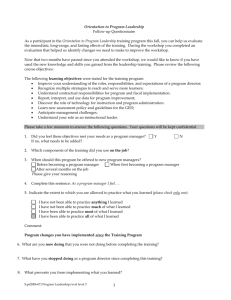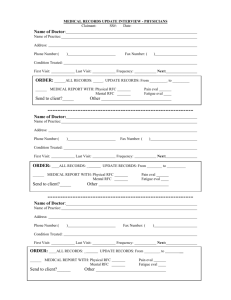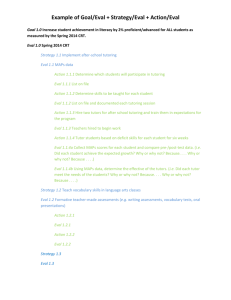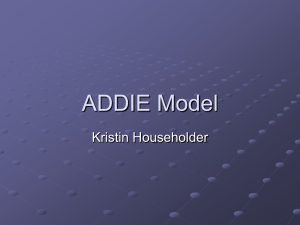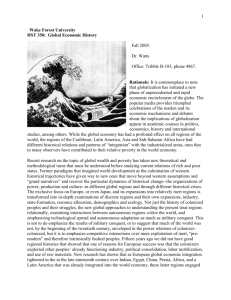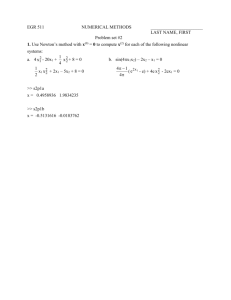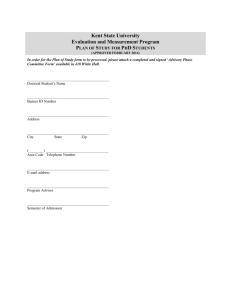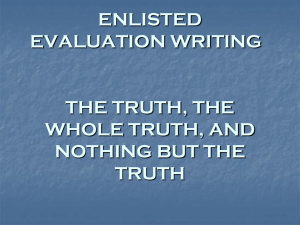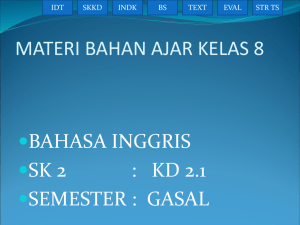Quality Improvement - Pediatric Residency Program
advertisement
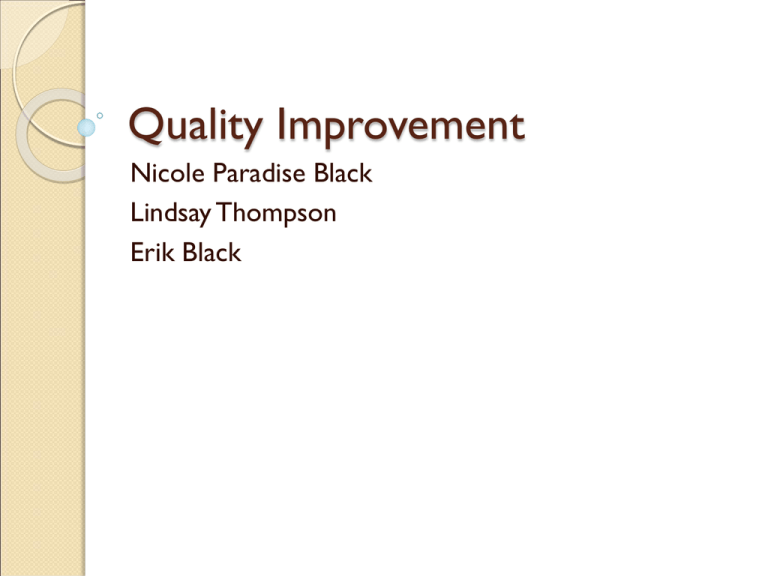
Quality Improvement Nicole Paradise Black Lindsay Thompson Erik Black Why is QI Important? $$$ Improvements in quality translate to…. Improved patient experience (more referrals) Expedited accounts receivable (more $$$) Improved patient health (kinda important) Reduction in expenses (more $$$) The goals of the QI process for you We are providing you with the tools and opportunity to learn how to conduct quality improvement projects You will utilize this skill for the rest of your career (whether informally or formally through MOC, aka maintenance of certification for the ABP). The Improvement Model What are we trying to accomplish? How will we know that a change is an improvement? What changes can we make that will result in improvement? PDSA- Plan Do Study Act Plan ◦ Always includes a prediction Do--test the change Study ◦ Did my prediction hold? ◦ What assumptions need revision? Act ◦ Adapt ◦ Adopt ◦ Abandon PDSA • Act • Plan What changes are to be made? Next cycle? • Study Complete analysis of the data • Compare data to predictions • Summarize what was learned Objectives • Questions and predictions (why) • Plan to carry out the cycle (who, what, where, when) Carry out the plan • Document problems & unexpected observations • Begin analysis of the data • Do PDSA: cycles for testing Increase your belief that the change will result in improvement Opportunity for “failures” without impacting performance Document how much improvement can be expected from the change Learn how to adapt the change to conditions in the local environment Evaluate costs and side-effects of the change Minimize resistance upon implementation Aim Statements Answers the first question: What are you trying to accomplish? Aim statements: which one is the best? I will give a talk about how to do quality I will explain how to use the model for improvement By 2pm on 5/6/10, 75% of QI 101 participants will have completed SMART Aim statements. Aim statements: which one is the best? I will give a talk about how to do quality I will explain how to use the model for improvement By 2pm on 7/26/09, 75% of QI 101 participants will have completed SMART Aim statements. SMART Aim statement A written statement of the accomplishments expected from team’s improvement effort ◦ ◦ ◦ ◦ ◦ SPECIFIC MEASURABLE ACTION-ORIENTED REALISTIC and RELEVANT TIMELY Another example We will decrease the rates of bloodstream infection. We will implement the insertion and maintenance bundles as recommended by the CDC. We will decrease the rates of catheter-acquired blood stream infections for all PICU patients to less than 2/1000 device days by July, 2010. Learning structure A diagram that organizes the “theory of improvement” for a specific project. Connects the outcome (Aim), key drivers with measures & design changes. Learning Structure Key drivers Aim Design changes, interventions Key drivers- critical issues Ideal = evidence or data-based Important to revisit as you understand the project more By convention they should be stated in the affirmative Identifying key drivers If no evidenced or data-based drivers are known, ask: ◦ What is necessary to achieve this aim? ◦ Consider the following: Performance of a component of a system (e.g., MD fills out a form) An operating rule or value (e.g., RT owns asthma education) An element of system structure (e.g., real time data for discharge time failure) Learning Structure Key drivers Finish Previous Case 1. Hemostasis & bandage 2. Extubation 3. Transfer pt to recovery Aim To decrease mean (and SD) time between cardiac caths by 50% by Jan 1, 2010 Next patient ready 1. Present 2. Consents obtained 3. Sedation given 4. Transfer to cath lab Cath Lab Preparation 1. Clean lab 2. Clean anesthesia equip 3. Table preparation 4. Computer & check list Staff Readiness 1. Cath nurses 2. Radiology tech 3. Cardiologists 4. Anesthesiologist Design changes, interventions •Hemostasis in holding room •Extubate in holding room •Rectal chloral hydrate if necessary Call CCU early to transfer pt Call Housekeeping early Call Anesthesia Tech early Selecting an improvement idea to test- how to gather data Process watch Flow chart Evidence/best practices Voice of the customer Brainstorming Change concept Change concepts vs. specific changes Vague, strategic, creative Improve process to reduce anxiety Provide families with freedom to leave waiting room Use beepers for family and friends waiting Specific actionable results Make beepers available to sample of families next week Measurement for Quality Improvement You can’t improve what you can’t (or don’t) measure. Measures tell a team if the changes they make are making a difference. The team needs just enough data to tell if the change is making an improvement. Should speed improvement, not slow it down. Measurement is not the goal. Our take on QI Keep it simple, don’t try to save the world Talk to the experts (fellow residents, attendings, nurses, other staff) Remember the scientific method That Scientific Method Thing… Define the question Gather information and resources Form hypothesis Perform experiment and collect data Analyze data Interpret data and draw conclusions that serve as a starting point for new hypotheses Publish results An Example: Back to sleep in the NICU Problem: Based on limited analysis, a significant number of NICU patients are not being placed to sleep on their backs. 1. 2. 3. 4. 5. 6. 7. Define Question Gather Information and Resources Form Hypothesis Perform Experiment/Collect Data Analyze Data Interpret Data Publish Results Low-touch Intervention Data Collection PROJECT TIMELINE NICU EVALUATION - PRE Task 10/1 10/3 10/5 10/7 10/10 10/12 10/14 10/16 11/10 11/12 11/14 11/16 EVAL 1 – DAY – 11am EVAL 2 – DAY – 2pm EVAL 3 – DAY – 9am EVAL 4 - DAY WEEKEND EVAL 5 – NIGHT – 9pm EVAL 6 – NIGHT – 1am EVAL 7 – NIGHT – 5am EVAL 8 – NIGHT WEEKEND INTERVENTION PROJECT TIMELINE NICU EVALUATION - POST Task 11/1 11/3 11/5 11/7 EVAL 1 – DAY – 11am EVAL 2 – DAY – 2pm EVAL 3 – DAY – 9am EVAL 4 - DAY WEEKEND EVAL 5 – NIGHT – 9pm EVAL 6 – NIGHT – 1am EVAL 7 – NIGHT – 5am EVAL 8 – NIGHT WEEKEND PROJECT TIMELINE NICU EVALUATION - POST Task EVAL 1 – DAY – Random EVAL 2 – NIGHT – Random EVAL 3 – DAY – Random EVAL 4 - NIGHT - Random 12/1 12/2 1/1 1/2 Analysis and Interpretation For each count: number on back and total population. Chart Progress. Perform t-tests and compared day vs night shift, ANOVA of longitudinal results comparing months. Interpretation of data. Other forms of evaluation Focus groups (pre-post intervention): consider bias Questionnaires: consider reasonable numeric significance Chart reviews (pre-post intervention): consider reasonable numeric significance Example of data measurement using a run chart Gather data ◦ Need a minimum of 12 points to establish a baseline. ◦ Need 20 – 25 points to detect meaningful patterns Create a graph ◦ Vertical scale (Y-axis): Measurement of interest ◦ Horizontal Scale (X-axis): Time or sequence Plot the data Calculate the centerline (median or mean) Annotate improvement interventions Run chart example: CVL infections •Staff care education •CHG Scrub for care line and insertions •Maximal sterile barriers Max Cap introduced The Project Description Worksheet Due by September 1, 2010 Mentor: Project description (brief paragraph providing general idea of project): Initial Aim Statement (can be less specific than SMART Aim statement): Timeline (pre-implementation data gathering, implementation, post-implementation data gathering): The Project Description Worksheet Due by December 15, 2010 Pre-implementation data findings: SMART Aim statement (specific, measurable, action-oriented, realistic/relevant, timely): Key Drivers (should be stated in the affirmative and list all key drivers even if you are not going to target them for change): Design Change(s)/Intervention(s): Measure(s): The Project Description Worksheet Due by June 1, 2011 Project is complete. Preparing for platform presentation or poster presentation to occur during that month. Project Description Worksheet, presentation and evaluation of project will be placed in your electronic portfolio. Remember Handing in stuff before deadlines is ALWAYS welcomed! If you are having trouble meeting a deadline, just let us know (we are understanding folks!) We love to see your faces, if you’re stuck come and talk to us!
